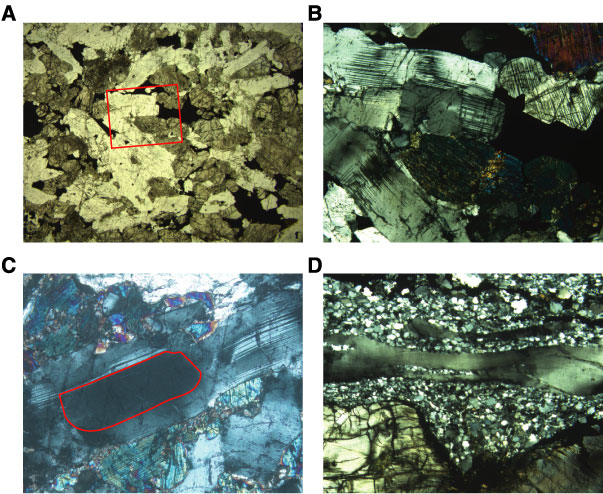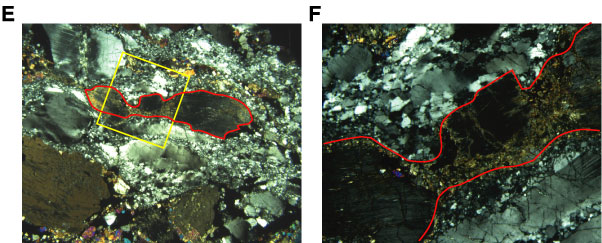
Figure F12. Photomicrographs depicting the variations in deformation of the oxide gabbronorites ranging from relatively undeformed to strongly deformed. A–C. This oxide-gabbronorite has an undeformed igneous texture with lath-shaped euhedral plagioclase, subhedral to euhedral clinopyroxenes, subhedral orthopyroxene, and interstitial oxides (Sample 209-1270B-10M-1, 117–120 cm). (A) The red box indicates the position of the magnified image in B (plane-polarized light: blue + dark gray filter; field of view [FOV] = 11 mm; image 1270B_033). (B) Close-up showing that although the texture is magmatic the rock has experienced some deformation as indicated by kinked plagioclase and release of strain associated with the polysynthetic twinning (cross-polarized light [XPL]: blue + dark gray filter; FOV = 2.75 mm; image 1270B_034). (C) Preservation of an optically zoned core (outlined in red) in a slightly deformed plagioclase (XPL: blue filter; FOV = 1.4 mm; image 1270B_013). D. Ribbon-textured plagioclase surrounded by plagioclase neoblasts in a strongly deformed oxide gabbronorite (Sample 209-1270B-1R-1, 90–93 cm) (XPL: blue filter; FOV = 2.75 mm; image 1270B_036).
E, F. Sample 209-1270B-4M-1, 108–111 cm. (E) A stretched orthopyroxene grain is outlined in red. It sits in a matrix of plagioclase neoblasts and has a neoblast of orthopyroxene in the middle of the grain where it has failed. The yellow box shows the location of a detailed view of the central boudinaged part of this grain
(XPL: blue filter; FOV = 11 mm; image 1270B_037). (F) Detail of a boudinaged orthopyroxene crystal with neoblasts of orthopyroxene and plagioclase
(XPL: blue filter; FOV = 2.75 mm; image 1270B_038).





![]()